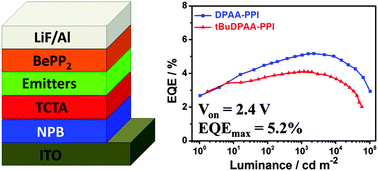Non-doped luminescent material based organic light-emitting devices displaying high brightness under very low driving voltage†
Abstract
Two phenanthro[9,10-d]imidazole (PI) derivatives, 9-N,N-diphenyl-amino-10-(4-(1-phenyl-1H-phenanthro[9,10-d]imidazol-2-yl)phenyl)anthracene (DPAA-PPI) and 9-N,N-dipheny-amino-10-(4-(1-(4-tert-butylphenyl)-1H-phenanthro[9,10-d]imidazol-2-yl)phenyl)anthracene (tBuDPAA-PPI), have been designed and synthesized. The two compounds exhibited high photoluminescence quantum yields (at around 0.80) in the solid state and bipolar carrier transport properties. The non-doped OLEDs using DPAA-PPI and tBuDPAA-PPI as emitting layers showed the maximum power efficiencies (PEs) of 13.9 lm W−1 and 11.4 lm W−1, corresponding to the maximum external quantum efficiencies (EQEs) of 5.2% and 4.1%, respectively. The DPAA-PPI-based OLED exhibited an extremely low turn-on voltage of 2.4 V and its luminescence reached 100, 1000, 10 000 and over 100 000 cd m−2 under driving voltages of 2.8, 3.6, 5.1 and 7.5 V, respectively.


 Please wait while we load your content...
Please wait while we load your content...